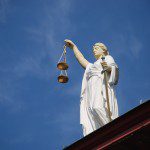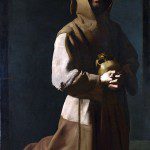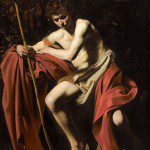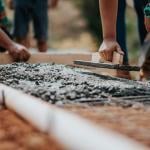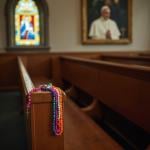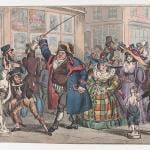“I did once say that to me art and the saints are the greatest apologetic for our faith.”– Pope Benedict XVI
Years ago, as a young university student, I was privileged to sing in the college choir. Perhaps the greatest honor of my singing career was embarking on a European tour with concerts in some of the greatest cathedrals in the world. Surrounded by the ferocious gargoyles of Notre Dame, standing atop the labyrinth in Chartres Cathedral, or simply wrenching our necks to peer heavenward in Cologne Cathedral, our choir would sing Ave Maria, Ubi Caritas, and other holy works. Needless to say, the experience was breathtaking. Unfortunately, I feel a bit melancholy that some of it was wasted on a twenty-year old who, at times, was more interested in flirting with the soprano section, than absorbing the sheer majesty of offerings to God around me. Nonetheless, in spite of the immature distractions of a college man, it was impossible not to be overwhelmed by these holy and historical works. It was my first true experience with sacred art. And it was magnificent.
Today, eighteen years later at a Mass in my home parish of St. Bartholomew’s Catholic Church, I found myself once again in awe. Adorning a formerly naked corner of the cavernous sanctuary, were four large bronze figures: “The Holy Family” sculpted by the famous artist, John Collier. Years ago, my family was in attendance for the dedication of John’s first sculpture, the marvelous figure of the crucified Christ, struggling to breath in his last moments of agony while surrounded by painted angels. It is a heart-wrenching depiction of Christ’s assurance to St. Bartholomew (also know as Nathanael) as recorded in John 1:51:
I tell you the truth, you shall see heaven open, and the angels of God ascending and descending on the Son of Man.
John’s work dramatically depicted Christ’s glory and shame embodied in his eternal sacrifice for our eternal gain. It is a sobering, yet inspiring reminder to every witness of the work that we are called to great sacrifice because the Greatest Sacrifice has already been made for us. This is the power of John’s art…it tells of the much greater power of Christ.
Now, we are introduced to “The Holy Family”. And due to a technical inability to import the image, please envision it as I describe (as in the fashion of returning pilgrims in centuries past) what was before me. Four bronze sculptures stand independent of one another on a platform. We find a twelve-year old Jesus furthest lateral in the group – nearly in the corner. He is at ease, yet with purpose as he strides somewhat ahead of the others. His destination? Jerusalem. As a child, it is to the seat of God’s religious authority on Earth. It is to the Temple to which all the faithful will, at one point or another, embark on a pilgrimage. But Jesus’ stride toward Jerusalem is not simply part of his family’s journey, but rather it is toward His Passion, His Death, and His Resurrection that only He can endure and deliver. For that reason, He is leaning several steps ahead of His family. Jesus is in essence, Alone. Of note, and almost emotionally crushing, the boy Christ’s path ahead of him is the side aisle with the Stations of the Cross engraved in the floor. And votive candles, emerge from the accompanying side wall, seemingly represent the silent, faithful, and memorializing witnesses to the selfless agony the Christ will endure on their (and our) behalf.
Next to the boy Jesus, is Mary. She is closest to Jesus – physically and emotionally. She lets him move forward, knowing the Call He must answer. Mary draws Jesus’ attention to the young girl farthest away from them. Jesus kindly acknowledges this in his posture, but must move toward his Passion with diligence and steadfast nature. Joseph, somewhat separate from Mary and Jesus, stands holding a staff as fatherly protector. He knows that the bond between Christ and Mother exceed his understanding in spite of his presence from the beginning. Joseph will serve his part – with strength, honor, and courage. Finally, a fourth sculpture debuts. The classic “Holy Family” has been depicted in the figures of Christ surrounded by Mary and Joseph. John Collier has brought a level of genius to his work. The fourth figure, a diminutive young woman, is us. The Church. The Body or Bride of Christ. With naiveté and yet great devotion, she greatly appreciates the boy Jesus’ acknowledgement, but knows He has a terrible and wonderful Call that he must attend to. She will patiently wait and take His guidance. Her Bridegroom must die, then rise so that she may be his Bride. With a touch of brilliance, John Collier places a pearl firmly in her hand symbolizing Matthew 13:45-46:
Again, the kingdom of heaven is like a merchant seeking beautiful pearls, who, when he had found one pearl of great price, went and sold all that he had and bought it.
The Church, that is all of us, have found in Christ the “Pearl of Great Price”. It is up to us to leave all for Him. To further reinforce the Holy Family’s embrace of all of us, the inscription at the base of the sculptures is taken from Matthew 12:50 which was Christ’s answer to those who told him his mother and brothers were looking for him:
The sculptures kindly command attention. Collectively, they tell a story, but each figure tells a story by itself. They draw us into a family drama because we, too, are part of this Family. Collier’s “The Holy Family” is sacred art that complements, edifies, and enlarges the way we are moved by the spoken or sung word. Put simply, its impact is tremendous.
The dedication ceremony, embedded in a Mass, was subdued and respectful. John Collier, also well-known for his 9/11 memorial sculptures, thoughtfully provided the narrative he sought to create. Our priest, Father Michael Reding, blessed the art as the swinging censer of incense enveloped the figures with a fingers of smoke and a sweet aroma. The moment was rich in poignancy. Sacred Art had become devotion. It was now Sacred Art as an offering to God.
As I was witness to this prayerful dedication, I found myself emotionally looking back to my European choir tour. The trip wasn’t simply about seeing new sights and experiencing new cultures. It wasn’t about me and a “voyage of self-discovery”. It was about quietly and earnestly providing a musical offering while simultaneously being surrounded by architecture and art that themselves were sacred oblations to God. I now understood the indispensability of Sacred Art. Towering, immovable cathedral pillars were crafted by men and women earnestly offering their blood, their toil, and their lives as an eager devotion to the glory of God. Rich tapestries and sculptures were created with painstaking beauty and detail simply to retell the stories of God’s favored ones. Exquisite music whose sweet or painful chords were composed to exalt your hope or break your heart. And now, a Holy Family, crafted to capture a pivotal moment in Christ’s family life and yet humble enough to invite us into the narrative as well. Christ’s story of truth, goodness, and beauty are captured in architecture, art, and music. The brilliance of John Collier, the generosity of many benefactors, and the grace of God brought this magnificent work of art to my parish church. This is Sacred Art. And without question, it is indispensable.







